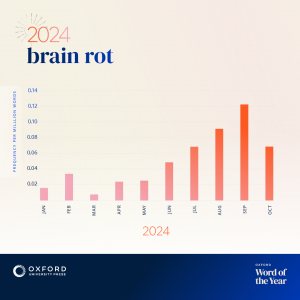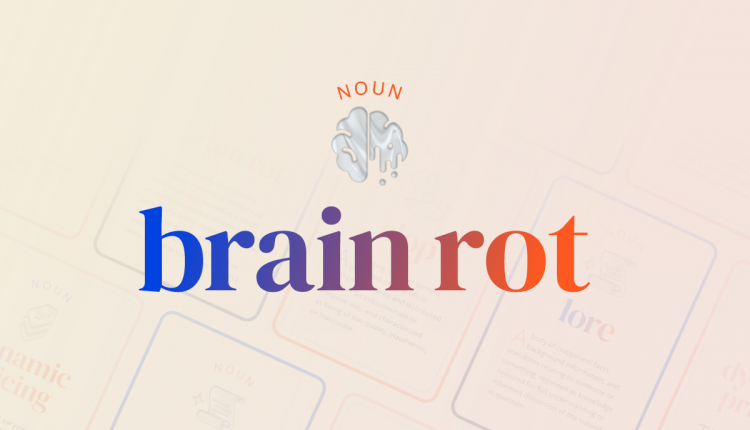Is Social Media Giving Us Brain Rot
Exploring the viral rise of brain rot and its deeper implications for our mental health in the digital age.
The term brain rot recently gained prominence as Oxford University Press declared it the 2024 Word of the Year. This phrase has sparked widespread discussion about the impact of excessive online content consumption on our mental well-being. While it sounds lighthearted, it reflects a deeper societal concern about how trivial and low-value online content—particularly through social media—may be affecting our intellectual and emotional health.
What is Brain Rot
Initially coined by Henry David Thoreau in 1854 to criticize societal superficiality, brain rot has evolved to capture modern anxieties about internet culture. Today, it refers to the perceived mental stagnation caused by overconsumption of trivial online content, often associated with endless scrolling on platforms like TikTok and Instagram. The term embodies both the cause (low-quality content) and the effect (mental fatigue or reduced intellectual engagement) of such habits.
The Viral Surge
The phrase took off among Gen Z and Gen Alpha on platforms like TikTok, where it became a humorous yet self-aware commentary on the addictive nature of viral trends. From absurd memes to surrealist video formats like the Skibidi Toilet series, brain rot encapsulates the mind-numbing loop of consuming nonsensical but strangely compelling content. According to Oxford Languages, its usage skyrocketed by 230% between 2023 and 2024, reflecting growing awareness and critique of these behaviors.

Why It Matters
While brain rot is often used humorously, it has sparked a broader discussion about the real mental health risks of constant online engagement. Studies link excessive screen time to cognitive decline, lower gray matter volume in the brain, and heightened risks of mental health issues like anxiety and depression. For younger generations, this can translate to developmental concerns, reduced attention spans, and challenges in processing complex information.
Historical Perspectives on Brain Rot
It’s fascinating that concerns about intellectual decline predate the internet. When Henry David Thoreau first mentioned brain rot in the 19th century, he was lamenting the simplification of thought and the prioritization of trivial ideas over intellectual depth. In the mid-20th century, similar fears arose with the advent of television. Researchers linked prolonged TV viewing to lower verbal IQ scores and reduced brain volume, showing that the fear of cognitive stagnation has evolved with each technological leap.
The Self-Aware Generation
Interestingly, the communities most associated with brain rot—younger, digitally native groups—are also its most vocal critics. This self-awareness manifests in memes, slang, and discussions that blend humor with genuine concern about their screen habits. This duality highlights a nuanced relationship with technology: while it offers entertainment and connection, it also demands a conscious approach to avoid potential downsides.
The Psychology Behind Brain Rot
Social media platforms are designed to captivate users through algorithms that exploit human psychology. The dopamine-driven feedback loops created by likes, shares, and comments make it difficult to break free. Psychologists suggest that this mechanism mirrors the addictive patterns seen in gambling, turning casual use into compulsive habits that exacerbate brain rot. This constant engagement with fleeting, low-value content can reduce our ability to focus on deeper, more meaningful tasks.

The Social Media Paradox
Social media platforms are simultaneously praised for connecting people and criticized for encouraging superficial engagement. They give everyone a voice, but this democratization often leads to an overabundance of trivial content. Viral trends and memes dominate feeds, pushing meaningful discussions to the sidelines. This paradox is a major contributor to brain rot—we’re consuming more but engaging less deep.
The Science of Distraction
Studies in cognitive neuroscience reveal that multitasking between apps, notifications, and media reduces our brain’s efficiency. Constantly switching attention affects the prefrontal cortex, leading to reduced cognitive control and decision-making abilities. Over time, this scattered focus can hinder our ability to engage in sustained, meaningful tasks, reinforcing the symptoms of brain rot.

The Role of Online Culture in Language Evolution
The rise of brain rot also highlights how internet culture is shaping language. Words like skibidi (nonsensical) and Ohio (weird or embarrassing) have emerged as part of a broader vocabulary linked to viral trends. This linguistic creativity shows the internet’s potential as a dynamic cultural force, even as it raises questions about the long-term impact of consuming such content.
The Role of Tech Companies
Tech companies bear a significant responsibility in curbing brain rot. Many platforms optimize for user engagement at the expense of mental well-being. While some have introduced features like screen time tracking, critics argue that these efforts are insufficient. A shift towards prioritizing meaningful interactions over addictive algorithms could alleviate some of the effects.
Global Conversations About Digital Detox
The concept of a digital detox has gained traction worldwide as a response to brain rot. Initiatives encouraging people to take breaks from their screens, such as National Day of Unplugging in the US, aim to restore balance. In countries like Japan, the practice of shinrin-yoku (forest bathing) has been adapted for tech users, promoting mindfulness and reconnection with nature.
Comparing Brain Rot Across Generations
It’s interesting to consider how different generations interpret and respond to brain rot. While Gen Z and Gen Alpha popularized the term, older generations often express concerns about their constant screen time. However, older adults are not immune; they, too, fall victim to echo chambers and repetitive low-value content, such as clickbait articles or polarized political meme.
A Call for Balance
Experts suggest that instead of vilifying technology, we should focus on mindful consumption. Understanding why we engage with certain types of content and setting boundaries can help mitigate the negative impacts of digital habits. Not all online activity is harmful—some can be enriching—but it’s essential to curate our digital diets thoughtfully.
Practical Tips to Avoid Brain Rot
For those worried about falling into the brain rot trap, here are some practical steps:
- Set screen time limits: Use apps or built-in features to monitor and control your usage.
- Prioritize quality over quantity: Follow creators who produce meaningful, thought-provoking content.
- Schedule offline time: Dedicate portions of your day to tech-free activities, like reading, exercising, or spending time outdoors.
- Cultivate critical thinking: Actively question the content you consume instead of passively scrolling.
The Positive Side of Digital Content
Not all digital content contributes to brain rot. Educational resources, online courses, and virtual communities can provide immense value. Platforms like TED, Khan Academy, and niche interest groups support intellectual growth and connection. Recognizing and amplifying such positive examples is key to reshaping the narrative around digital engagement.
The Larger Picture
Brain rot reflects our growing discomfort with how much of our lives revolve around screens. As our virtual and real lives intertwine, terms like this act as cultural markers, prompting us to reflect on how we use technology and how it shapes our thinking and well-being.
It captures a universal struggle in the digital age: finding balance in a world overflowing with trivial distractions. While the internet offers unprecedented access to information and connection, it also demands careful navigation to avoid its pitfalls. Embracing mindfulness, setting boundaries, and seeking enriching content are steps we can take to preserve our mental and emotional well-being in a rapidly evolving digital landscape.

